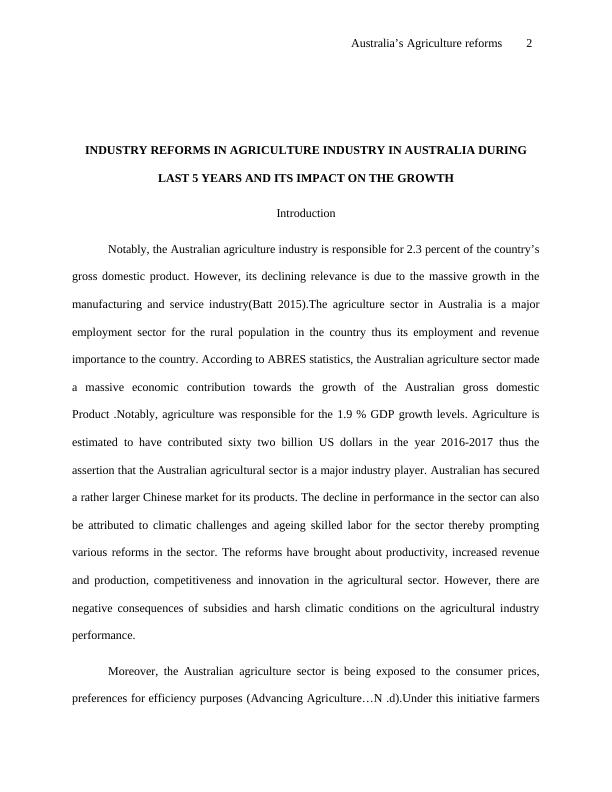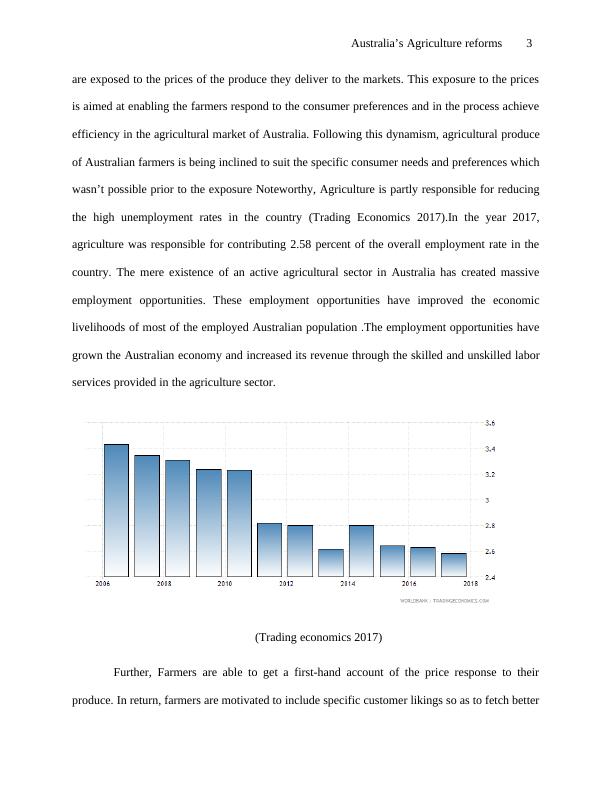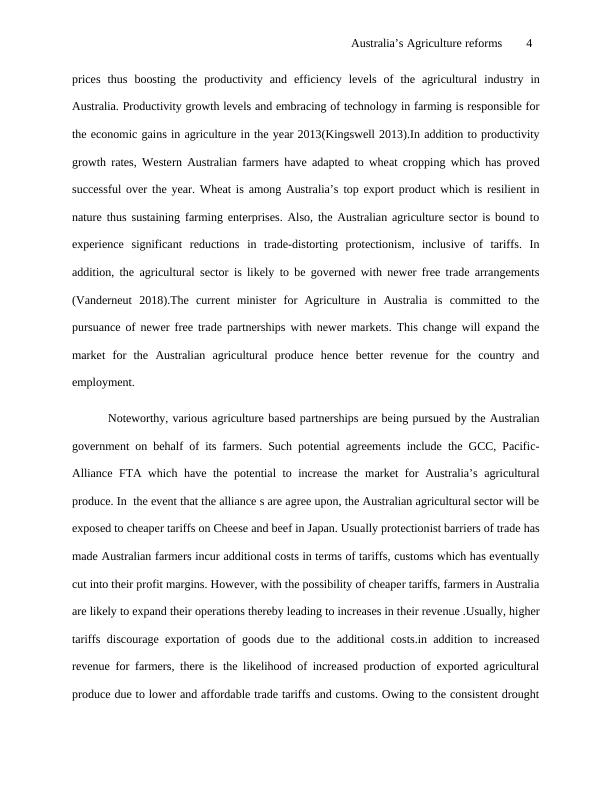Industry Reforms in Agriculture Industry in Australia - PDF
Added on 2021-06-15
14 Pages3191 Words36 Views
Australia’s Agriculture reforms 1ECONOMIC AND INTERNATIONAL TRADENameClassProfessorInstitution/City/StateDate

Australia’s Agriculture reforms 2INDUSTRY REFORMS IN AGRICULTURE INDUSTRY IN AUSTRALIA DURINGLAST 5 YEARS AND ITS IMPACT ON THE GROWTHIntroductionNotably, the Australian agriculture industry is responsible for 2.3 percent of the country’sgross domestic product. However, its declining relevance is due to the massive growth in themanufacturing and service industry(Batt 2015).The agriculture sector in Australia is a majoremployment sector for the rural population in the country thus its employment and revenueimportance to the country. According to ABRES statistics, the Australian agriculture sector madea massive economic contribution towards the growth of the Australian gross domesticProduct .Notably, agriculture was responsible for the 1.9 % GDP growth levels. Agriculture isestimated to have contributed sixty two billion US dollars in the year 2016-2017 thus theassertion that the Australian agricultural sector is a major industry player. Australian has secureda rather larger Chinese market for its products. The decline in performance in the sector can alsobe attributed to climatic challenges and ageing skilled labor for the sector thereby promptingvarious reforms in the sector. The reforms have brought about productivity, increased revenueand production, competitiveness and innovation in the agricultural sector. However, there arenegative consequences of subsidies and harsh climatic conditions on the agricultural industryperformance.Moreover, the Australian agriculture sector is being exposed to the consumer prices,preferences for efficiency purposes (Advancing Agriculture...N .d).Under this initiative farmers

Australia’s Agriculture reforms 3are exposed to the prices of the produce they deliver to the markets. This exposure to the pricesis aimed at enabling the farmers respond to the consumer preferences and in the process achieveefficiency in the agricultural market of Australia. Following this dynamism, agricultural produceof Australian farmers is being inclined to suit the specific consumer needs and preferences whichwasn’t possible prior to the exposure Noteworthy, Agriculture is partly responsible for reducingthe high unemployment rates in the country (Trading Economics 2017).In the year 2017,agriculture was responsible for contributing 2.58 percent of the overall employment rate in thecountry. The mere existence of an active agricultural sector in Australia has created massiveemployment opportunities. These employment opportunities have improved the economiclivelihoods of most of the employed Australian population .The employment opportunities havegrown the Australian economy and increased its revenue through the skilled and unskilled laborservices provided in the agriculture sector. (Trading economics 2017) Further, Farmers are able to get a first-hand account of the price response to theirproduce. In return, farmers are motivated to include specific customer likings so as to fetch better

Australia’s Agriculture reforms 4prices thus boosting the productivity and efficiency levels of the agricultural industry inAustralia. Productivity growth levels and embracing of technology in farming is responsible forthe economic gains in agriculture in the year 2013(Kingswell 2013).In addition to productivitygrowth rates, Western Australian farmers have adapted to wheat cropping which has provedsuccessful over the year. Wheat is among Australia’s top export product which is resilient innature thus sustaining farming enterprises. Also, the Australian agriculture sector is bound toexperience significant reductions in trade-distorting protectionism, inclusive of tariffs. Inaddition, the agricultural sector is likely to be governed with newer free trade arrangements(Vanderneut 2018).The current minister for Agriculture in Australia is committed to thepursuance of newer free trade partnerships with newer markets. This change will expand themarket for the Australian agricultural produce hence better revenue for the country andemployment. Noteworthy, various agriculture based partnerships are being pursued by the Australiangovernment on behalf of its farmers. Such potential agreements include the GCC, Pacific-Alliance FTA which have the potential to increase the market for Australia’s agriculturalproduce. In the event that the alliance s are agree upon, the Australian agricultural sector will beexposed to cheaper tariffs on Cheese and beef in Japan. Usually protectionist barriers of trade hasmade Australian farmers incur additional costs in terms of tariffs, customs which has eventuallycut into their profit margins. However, with the possibility of cheaper tariffs, farmers in Australiaare likely to expand their operations thereby leading to increases in their revenue .Usually, highertariffs discourage exportation of goods due to the additional costs.in addition to increasedrevenue for farmers, there is the likelihood of increased production of exported agriculturalproduce due to lower and affordable trade tariffs and customs. Owing to the consistent drought

End of preview
Want to access all the pages? Upload your documents or become a member.
Related Documents
Reforms in Agriculture Industry in Australialg...
|9
|1444
|50
Australia Agriculture Reforms: Impact on Economy and Farmerslg...
|13
|3321
|78
Economics and International trade assignmentlg...
|14
|3480
|33
Economics for Business - Reforms In Agriculture Industry In Australialg...
|7
|1223
|34
Reforms in Agriculture Industries in Australialg...
|9
|1617
|238
Economic Principle Assignmentlg...
|17
|3590
|147
